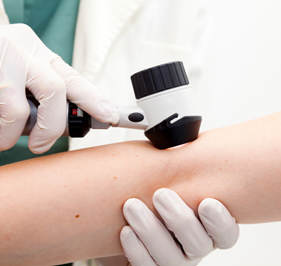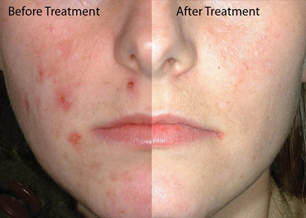
First, it’s important that everyone, including men, identify and understand their skin type:
- Sensitive skin may sting or burn after product use
- Normal skin is clear and not sensitive
- Dry skin is flaky, itchy or rough
- Oily skin is shiny and greasy
- Combination skin is dry in some areas and oily in others
Understanding your skin type will help you learn how to take care of your skin and select skin care products that are right for you. To help men develop healthy skin care routines, dermatologists recommend the following tips:
- Consider product labels and ingredients. The skin care products you choose will depend on your skin type. If you have acne-prone skin, look for cleansers and moisturizers that say “oil free” or “non-comedogenic,” as these won’t clog your pores. If you have sensitive skin, use mild, “fragrance free” products, as products containing fragrances can leave skin feeling irritated and dry. However, beware of products labeled “unscented,” as many of these contain masking fragrances that can still irritate your skin.
- Wash your face daily and after exercise. Because regular bar soap often contains harsh ingredients that can be drying to the skin, wash your face with a mild facial cleanser and lukewarm — not hot — water.
- Watch your shaving technique. For some men, multi-blade razors can work too well or shave too closely to your skin. If you often experience razor bumps, razor burns, or ingrown hairs, use a single- or double-blade razor instead and do not stretch your skin taut while shaving. Before you shave, wet your skin and hair to soften it. Use a moisturizing shaving cream and shave in the direction of hair growth. Rinse after each swipe of the razor, and change your blade after five to seven shaves to minimize irritation.
- Moisturize daily. Moisturizer works by trapping water in your skin, which can help reduce the appearance of fine lines and make your skin look brighter and younger. For the best results, apply moisturizer to your face and body immediately after bathing, showering or shaving while the skin is still damp.
- Check your skin regularly. New spots or moles that itch, bleed, or change color are often early warning signs of skin cancer. If you notice any suspicious spots, make an appointment to see a dermatologist. Men over age 50 have a higher risk of developing melanoma, the deadliest form of skin cancer, than the general population. However, when caught early, skin cancer is highly treatable.
- Wear sunscreen whenever outdoors. To help prevent sun damage that can lead to wrinkles, age spots and even skin cancer, before going outdoors, apply sunscreen to all exposed areas of skin, including your scalp, ears, neck and lips. For best protection, use a broad-spectrum, water-resistant sunscreen with an SPF of 30 or higher and reapply every two hours or immediately after swimming or sweating. You can also protect your skin by seeking shade and wearing sun-protective clothing, such as a lightweight and long-sleeved shirt, pants, a wide-brimmed hat and sunglasses with UV protection, when possible. For more effective sun protection, select clothing with an ultraviolet protection factor (UPF) label.
Every man’s skin is different, and there is no “one size fits all” approach to skin care. If you aren’t sure what skin type you have, or if have questions about how to take care of your skin, see a board-certified dermatologist.
Credit: AAD



 Even if you have carefully practiced sun safety all summer, it’s important to continue being vigilant about your skin in fall, winter, and beyond. Throughout the year, you should examine your skin head-to-toe once a month, looking for any suspicious lesions. Self-exams can help you identify potential skin cancers early, when they can almost always be completely cured.
Even if you have carefully practiced sun safety all summer, it’s important to continue being vigilant about your skin in fall, winter, and beyond. Throughout the year, you should examine your skin head-to-toe once a month, looking for any suspicious lesions. Self-exams can help you identify potential skin cancers early, when they can almost always be completely cured.
 Our expert dermatologist Dr. Benjamin Barankin was recently quoted in CityParent discussing acne in “Tips to clear up acne and angst”.
Our expert dermatologist Dr. Benjamin Barankin was recently quoted in CityParent discussing acne in “Tips to clear up acne and angst”.



 Are you embarrassed by how much you sweat? It’s normal to sweat when you get nervous or exert yourself. However, if you sweat easily or to the point where sweat is visible on your clothing when you aren’t exerting yourself, you may have a condition called “
Are you embarrassed by how much you sweat? It’s normal to sweat when you get nervous or exert yourself. However, if you sweat easily or to the point where sweat is visible on your clothing when you aren’t exerting yourself, you may have a condition called “